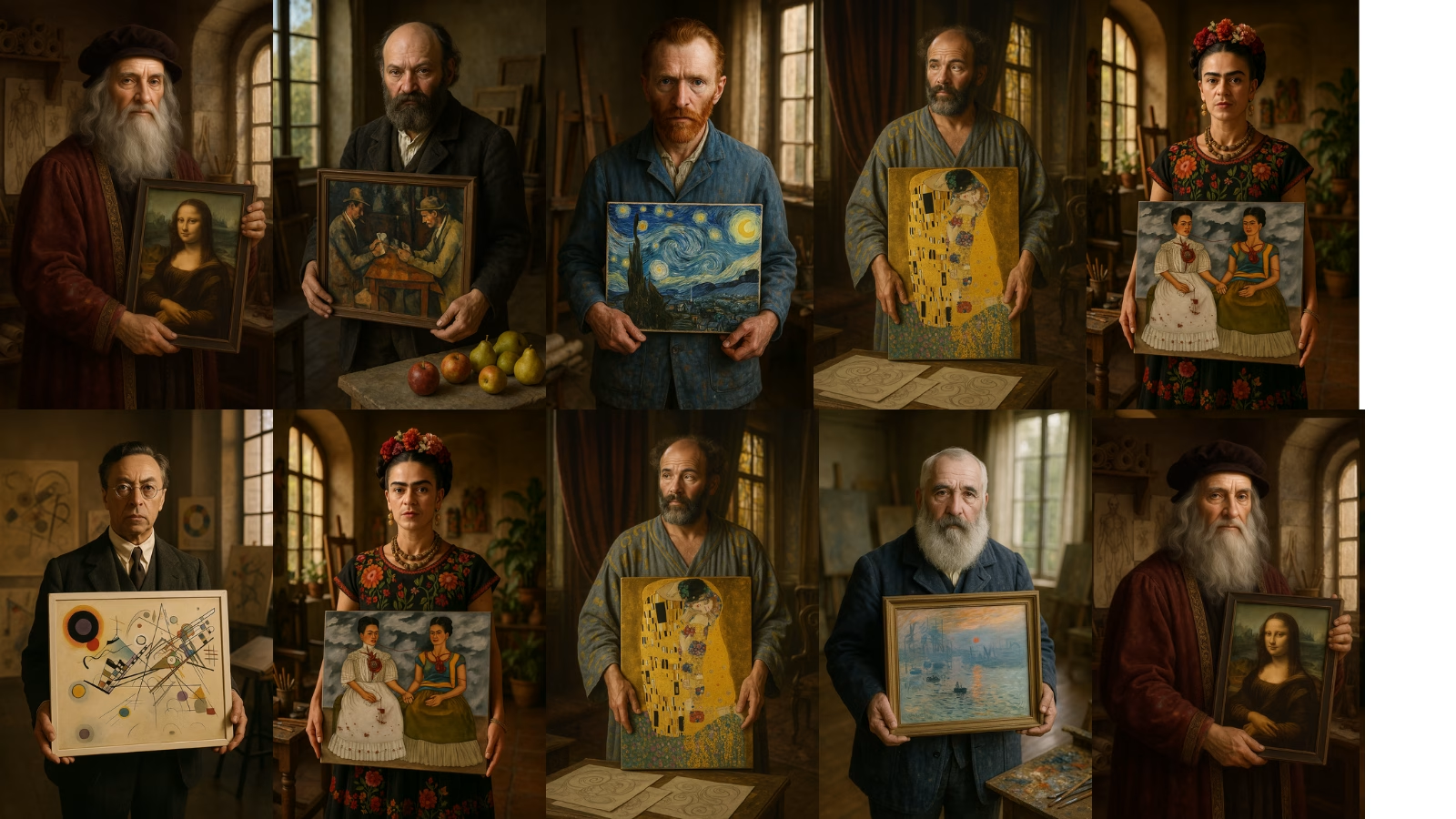Art sometimes speaks where words fall short. Each brushstroke carries the trace of a thought, a feeling, or a moment. From the enigmatic smile of Leonardo da Vinci’s Mona Lisa to the swirling skies of Van Gogh’s Starry Night, from Monet’s capture of the first impressionist shimmer at sunrise to Frida Kahlo’s confrontation with pain and identity in The Two Fridas, every work shares the artist’s soul with us. Klimt’s golden-hued love in The Kiss, Cézanne’s depth through silent peasants in The Card Players, Kandinsky’s abstract universe woven with colors—each is not just a painting but a story of an era, a person, and perhaps the viewer’s inner world. These works defy time, continuing to inspire us.
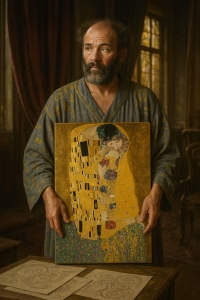
Gustav Klimt
Gustav Klimt, a symbolist painter influential in late 19th and early 20th century Austria, began his career with architectural decorations before developing his distinctive style, particularly focusing on the female form. A leading figure of the Vienna Secession movement, Klimt challenged and transformed the era’s artistic conventions with his use of gold leaf, intricate patterns, and erotic figures. His art often explores mythology, nature, and love, rendered in dreamlike compositions rich with symbolism.
The Kiss (1907–1908), created during Klimt’s “Golden Period,” is one of his most striking works. The painting depicts a couple embracing and kissing in a field of flowers, their bodies adorned with gold leaf and surrounded by abstract geometric patterns. While their faces and hands are rendered realistically, the rest creates a golden, dreamlike atmosphere. Beyond physical love, The Kiss symbolizes a spiritual union. Both romantic and mystical, it is displayed at Vienna’s Belvedere Palace and is considered one of modern art history’s most iconic works.
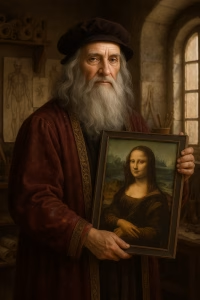
Leonardo da Vinci
A quintessential Renaissance polymath, Leonardo da Vinci was an Italian artist, inventor, engineer, and anatomist of the 15th century. Beyond his paintings, his scientific studies and visionary ideas left an indelible mark on history. His art, rooted in observation, admiration for nature, and a deep understanding of human anatomy, combines technical mastery with philosophical depth. His innovations, particularly in sfumato (light-shadow blending) and perspective, shaped art history.
Mona Lisa (1503–1506), housed in the Louvre Museum, is Leonardo’s masterpiece. The portrait, believed to depict Lisa Gherardini, features her subtle smile and gaze that seem to follow the viewer. Da Vinci’s masterful use of sfumato creates soft transitions, blending facial features and the background into a dreamlike atmosphere. More than a technical triumph, Mona Lisa proves art’s profound impact on human psychology.
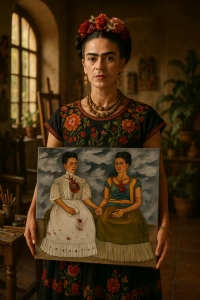
Frida Kahlo
One of the 20th century’s most iconic artists, Mexican painter Frida Kahlo created a unique artistic language by channeling her physical pain, emotional turmoil, and identity struggles into her work. Blending surrealism and folk art, her deeply autobiographical paintings boldly explore themes of womanhood, the body, pain, love, and belonging. Kahlo is renowned for her self-portraits, which externalize her inner world.
The Two Fridas (1939), painted after her separation from Diego Rivera, is one of Kahlo’s most powerful self-portraits. It depicts two Fridas side by side: one in traditional Mexican attire with an intact heart, the other in European dress with a wounded heart, holding scissors poised to cut an artery. This duality symbolizes Kahlo’s inner conflict and fragmented identity. The connecting vein suggests unity, yet the exposed heart reveals emotional pain. The Two Fridas vividly expresses not only the devastation of love but also the complexities of womanhood, cultural identity, and personal existence.
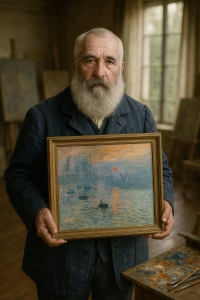
Claude Monet
A founder of French Impressionism, Claude Monet revolutionized art history in the late 19th century. Rejecting academic conventions, Impressionism aimed to capture nature and fleeting light effects. Monet pioneered this approach, painting outdoors to observe and reflect colors, light, and atmosphere. His loose brushstrokes and bold palette prioritized overall impressions over details, laying the foundation for modern painting and transforming traditional narrative.
Impression, Sunrise (1872), painted at Le Havre’s harbor, depicts an orange sun rising through gray-blue mist, with blurred ships in the foreground. Exhibited in 1874 at the first Impressionist show, its title “Impression” was initially mocked by critics but later defined the movement. Monet’s experimental approach to light and color sparked a revolution, making Impression, Sunrise not just a painting but a symbol of modernism’s birth.

Paul Cézanne
A pivotal French painter, Paul Cézanne bridged Impressionism and Cubism. By analyzing nature through geometric forms—spheres, cylinders, and cones—he offered a groundbreaking perspective. His approach influenced artists like Picasso and Braque, shaping 20th-century modernism. Cézanne’s works feature rhythmic repetition, intense observation, and timeless stillness in figures.
The Card Players (1890s), a series of five paintings, portrays silent peasant men playing cards around a table. Beyond a daily scene, Cézanne captures the introspective depth of these figures, frozen in time. Emotionless expressions, balanced composition, and structural formalism lend the work a sculptural quality. The Card Players marks both the peak of Cézanne’s mature period and a revolutionary turning point in modern figurative art.

Vincent van Gogh
A leading Post-Impressionist, Vincent van Gogh poured his inner turmoil onto the canvas with intense passion. Despite financial struggles and mental illness, he produced nearly 2,000 works in his short career. His bold, rapid brushstrokes and vibrant colors focus on emotional expression over realistic depiction. Recognized posthumously, his style pioneered modern Expressionism and abstract art.
The Starry Night (1889), painted during Van Gogh’s stay at Saint-Rémy’s asylum, reflects his view from his room, infused with imagination. Swirling stars, a crescent moon, and a turbulent sky create an atmosphere of both peace and chaos. The calm village below contrasts with the stormy heavens, mirroring Van Gogh’s mental state. More than a nightscape, The Starry Night is one of art history’s most poignant and universally resonant works.
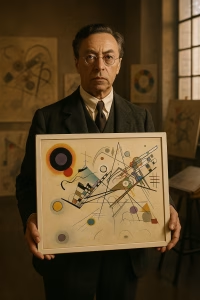
Wassily Kandinsky
Considered the founder of abstract art, Russian-born Wassily Kandinsky moved away from figurative art in the early 20th century, advocating that art should express emotions and spiritual vibrations. Equating art with music, he believed colors and forms had an inner resonance. His manifesto On the Spiritual in Art and his teaching at the Bauhaus shaped modern art.
Using circles, triangles, lines, and abstract color fields, Kandinsky’s Composition and Improvisation series convey his inner world and emotional energy, free from figurative ties. The rhythmic flow, balance, and geometric abstraction in his works, like the one in your image, reflect his artistic essence, aiming to evoke a personal resonance in the viewer.
So, which of these masterpieces stirs your soul? Share your thoughts, and let’s see which painting resonates most!



